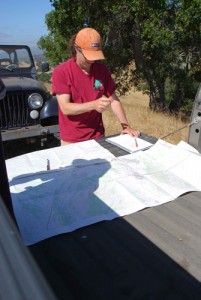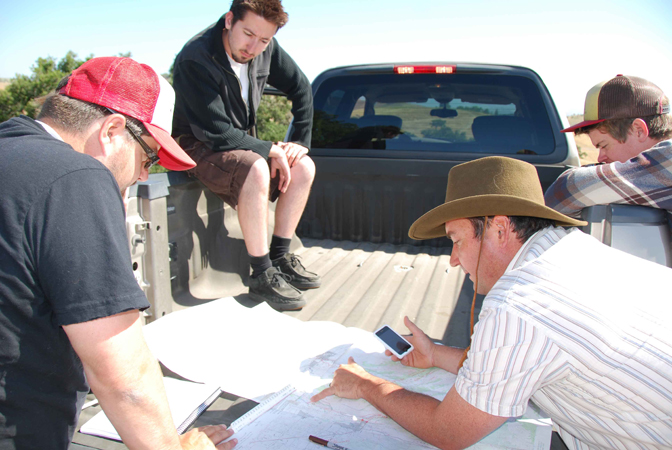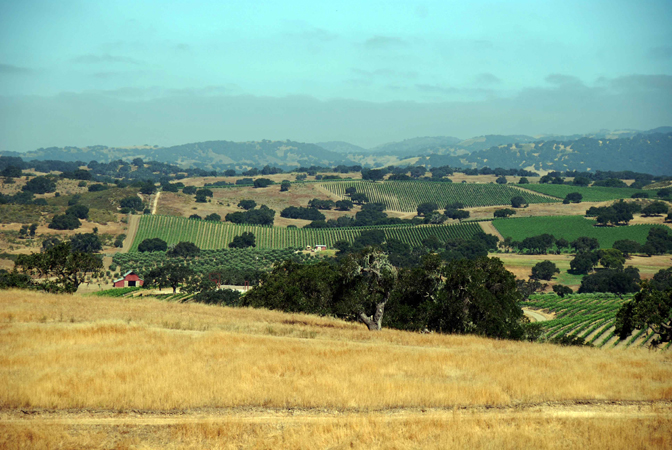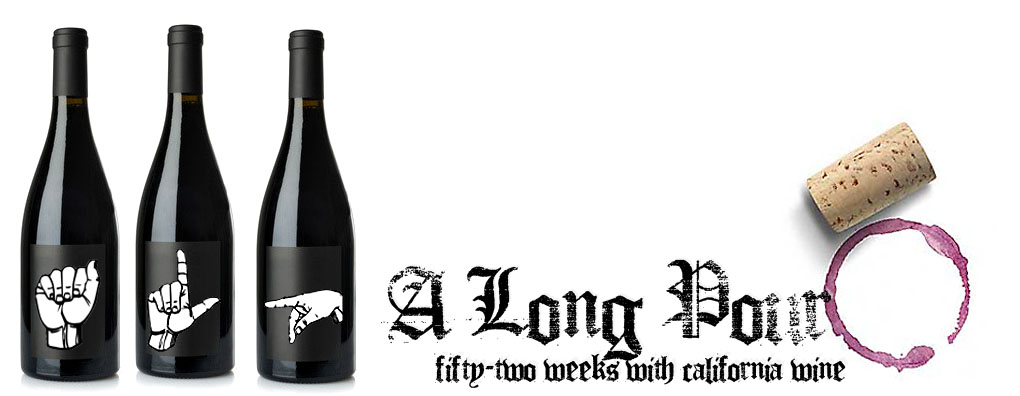“The Birth of an American Viticultural Area” By: Wes Hagen
Let’s take a slightly different view of the wine world this week. I’d like to leave the nuts and bolts of vineyard management for a few moments and discuss the descriptive system of wine appellations in the United States, a Federal program overseen by the TTB, or Tax and Trade Bureau. But before you start to think that this is going to be a boring blog full of bellicose bureaucracy, let me guarantee that I will be injecting the subject with enough interesting anecdote and incisive commentary to keep it interesting and entertaining (although pouring a tall glass of pinot noir makes any of my blogs more palatable).
First, a quick vineyard update. The weather has taken another cool, foggy and windy turn as low pressure trofs continue to move over the Central Coast, keeping us in the high 60’s. While most folks don’t think about June in California as sweater weather, it really has been. There have been some warm days, as well, but the nights have been in the high 40’s and the vines are growing slowly, methodically, and finishing their fruit set and marching toward bunch closure in a very patient and easy manner. Cool weather means we’ll turn off the irrigation for a few weeks until we see a warm up and an increase in evapotranspiration, which is a measurement of how much water is both being used by a plant and how much is evaporating out of the soil.
 So far the2010 vintage has been defined more by coolness (even cold) than warmth. That screams hang time and balance in the final product, but we do expect to see some warm ups as the season progresses. Cluster counts look somewhat bountiful, cluster weights may be a little light due to windy and cold weather during flowering, and we expect to see around 2-2.5 tons per acre in the Pinot Noir, and a bit less in the Chardonnay due to that damned April Fools Day frost. We’ll be in San Francisco next week for Pinot Days, and if I have time I’ll post a short little road blog, but I also want to eat and drink myself silly through one of my favorite cities in the world. I don’t get out much, so when I do I want to make it count.
So far the2010 vintage has been defined more by coolness (even cold) than warmth. That screams hang time and balance in the final product, but we do expect to see some warm ups as the season progresses. Cluster counts look somewhat bountiful, cluster weights may be a little light due to windy and cold weather during flowering, and we expect to see around 2-2.5 tons per acre in the Pinot Noir, and a bit less in the Chardonnay due to that damned April Fools Day frost. We’ll be in San Francisco next week for Pinot Days, and if I have time I’ll post a short little road blog, but I also want to eat and drink myself silly through one of my favorite cities in the world. I don’t get out much, so when I do I want to make it count.
So let’s talk a little about American Viticultural Areas and how they are created. As you may or may not know, one of my avocations is the research and writing of Federal Petitions for the establishment of AVA’s. It all started a bit randomly and serendipitously, when at an early meeting of the Santa Rita Hills Winegrowers I raised my hand at the wrong time. We had received a bid from some lawyers for $200,000 to write the petition to establish the Santa Rita Hills AVA, and we didn’t want to spend that kind of cash, so on that fateful day in Winter 1997 I raised my hand when Richard Sanford asked if anyone had any professional writing experience. They gave me the nod, a 28 year old kid just learning how to grow grapes, and suddenly I was the point guy for research and writing for what would become a famous (if not infamous) pinot noir and chardonnay winegrowing area.
But what the hell IS an AVA anyways. I’m a big fan of bullet items in my writing. It’s like a cup of coffee in the middle of an article. It always makes me feel like I’m getting through material quickly and that the writer understands my need for quick, meaningful snippets. So here we go:
What an AVA is:
- An AVA attempts to describe and make distinct grape growing areas that produce a typical style of wine due to geology and climate.
- An AVA sets a boundary through the Federal Register that, if 85% of the grapes used for a wine come from within that boundary, can be listed on the wine label. For instance ‘Napa Valley’ or ‘Santa Rita Hills’ on the wine label means 85%+ of the fruit used in the wine was grown within that specific AVA boundary.
- An AVA is petitioned for by an individual or a group that usually hires a writer/consultant (aka ME), to research the history, geology, geography, climate, etc and to put it into a thick and succinct package to be submitted to the Federal Government for review. If the petition is complete, it is published in the Federal Register for public comment, and then it is reviewed again by the TTB and the Treasury Department before final approval. At that point it is approved for use on labels as an appellation of origin.
- The TTB indicates that the purpose of an AVA is to inform customers where their wine comes from and to help alleviate consumer confusion. Still confused? Blame the AVA!
- The AVA system is a DESCRIPTIVE system, not a PRESCRIPTIVE system. It describes where the wine is grown, but does not guarantee quality.
- There is a movement in the AVA world to get a bit more specific in describing ‘meso-appellations’, smaller areas within existing larger AVA’s that are emerging as very special and specific climates that become famous for a single style of wine or a limited number of grape varietals. An excellent example of this is the Santa Rita Hills AVA or the Happy Canyon of Santa Barbara AVA (the two petitions that I wrote and researched)—the SRH being notable for pinot noir and chardonnay, and HCoSB becoming popular for Sauvignon Blanc and red Bordeaux varietals.
What an AVA is Not:
- As implied above, the AVA system does not guarantee a wine bearing a specific AVA (Napa Valley, Santa Maria Valley) has some innate qualities or superior flavor/aging ability/etc. The French AOC and the Italian DOC/DOCG systems often employ winemaking ‘policemen’ that do taste wines and have the authority to declassify them. Americans don’t like the government mucking about in their cellars, and to be honest I can’t imagine Federal AVA officers would have the palates or the prescience to do their jobs without being beaten with punch down tools, so we are both stuck and blessed with a system without ‘teeth’. In general winemakers comply with the 85% rule, and most AVA wines are probably closer to 100% fruit from a specific appellation.
- The term ‘appellation’ is generally synonymous with an ‘AVA’ in casual wine speak, but if you call it an ‘Appalachian’, we will laugh at you after you leave the tasting.
- Some AVA’s, especially old ones and really big examples, are fairly meaningless. For example, the Santa Ynez Valley AVA is so big that it covers 60 different varietals and over 300 clones. If an AVA (such as SYV or Russian River) covers everything from Pinot Noir (cool climate) to Zinfandel or Cabernet (warm weather), it’s generally a meaningless appellation of origin.
So how does an AVA come into existence?
- A very wise group of winegrowers in a defined area hires a researcher/writer, such as me!
- I get paid a retainer. Chanda dances a bit and the horse gets new shoes.
- The writer works with the group on boundaries of the area, mark up some maps, collects soil samples and reports, gathers climatic data from within and without the defined area and determines what makes the area provably unique.
- The data is massaged into an air tight argument of typicity, and the petition is crafted accordingly.
- Maps, data, exhibits, letters of support and the actual petition is submitted to the TTB AVA office in Petaluma, California and we wait for the email telling us they have received, reviewed and accepted the petition. Don’t celebrate—this is just the beginning.
- I get paid. I greedily eye a used Porsche, and Chanda reminds me of the horse.
- After publication of the petition in the Federal Register, there is a 90 days period of public comment. This is when someone who thinks the name or boundaries infringe on their ability to make money makes a stink. Or maybe a neighbor thinks it’s lame that the boundary cuts off half of their real estate. Or perhaps a different group of jerky winemakers are jealous and just want to be dicks about it. Fortunately, that’s Napa Valley and we all like each other down here in Santa Barbara County (for the most part), or if you are more pessimistic, there’s not enough money in the wine business down here for us to hate each other (yet).
- If the stars align and the Bureaucracy Bacchus smiles upon us, we get the Final Rule of Approval from the TTB and gain the ability to submit labels for approval (did you know every wine label in the US has to be approved before being applied?) with the new AVA name.
- I get paid, again.
- Rare tidbit: if you still have wine in barrel, or unlabeled bottles, etc., you can label them with a new AVA name as long as they are made after the original petition was accepted. So if we submit the ‘Ballard Canyon AVA’ petition before harvest 2010, and we get approval in 2012 (right before the world ends), we could retroactively label 2010 and 2011 wines as ‘Ballard Canyon’. Confusing but true!
 So why the hell are you telling us all about this?
So why the hell are you telling us all about this?
I began work this week on the new Ballard Canyon AVA petition. We had a meeting on Sunday in Michael Larner’s barn (at Larner Vineyard, a fabulous grower of Rhone varietals and the best Malvasia Bianca in the US), and discussed the project with winegrowers and neighbors. We decided to move forward with everyone’s blessing—the approval would certainly increase property value and the cache would also likely increase per-ton and per-acre grape contracts.
Ballard Canyon follows a creek and a road, Ballard Canyon Road, which runs from Los Olivos (north) to Buellton (south) to the 101 (west) and Alamo Pintado Road (East). The entire day yesterday was spent with some local winegrowers and winemakers (and generally cool guys) driving 4×4’s and hiking to 9 different points along the border of Ballard Canyon and determining, by actual scouting, soil analysis, GPS and USGS mapping, what should be included and what should be excluded.
The boundary will not be as important in our lifetime as it will in 3-4 generations when our work will be revisited and critiqued in every detail as this region becomes famous for Rhone varietals, and the properties are increasingly planted. Why was a line drawn from this hill to this hill? Why did they cut our property in half? We are taking this task very seriously and this is one reason why we needed to get on the ground in real time and challenge ourselves and our preconceptions..to push the limit of surveying and come to a clear consensus before bringing the rough draft maps back into a meeting and opening the boundary up to discussion.
There is a difference between how I surveyed the first two AVA petitions I have seen reviewed and approved (Santa Rita Hills and Happy Canyon, which if you are feeling masochistic you can view in all of its Petitioned Drudgery at http://snipurl.com/tc4kl ). This time we had iPhone and Blackberries and GPS units within them that we could drop pins and get latitude and longitude everywhere we visited. We also had Google Earth to bring satellite imagery right down into the bed of our pickup truck so we could orient ourselves either by lat/long lines, or figure out what was behind that hill over there, or figure out exactly where we were on the USGS maps we had open on the bed of the pickup truck for marking boundaries.
If you’re not familiar with the Ballard Canyon area, you would go just past the Hitching Post Restaurant toward Solvang, and turn left on Ballard Canyon Road. From there you travel all the way up Ballard Canyon from Buellton to the top of the road which comes out almost all the way into Los Olivos. Vineyards in the area include some of the best in the County: Larner, Stolpman, Jonata, Purisima Mountain (Beckmen), Tierra Alta, Rusack, Windmill (Saarloos), Harrison-Clarke and Kimsey. New vineyards are going in and there are also some small, hobbyist vineyards planted.
It was an awesome day of discovery as we circled and studied the boundaries and geology, and I look forward to updating all of you with timely information as the process of petitioning for the Ballard Canyon American Viticultural Area continues.
Wes Hagen is Vineyard Manager and Winemaker for Clos Pepe Vineyards in the Sta. Rita Hills. He writes the vineyard blog, “(Another) Year in the Vineyard.” He is an unabashed Lakers fan.


